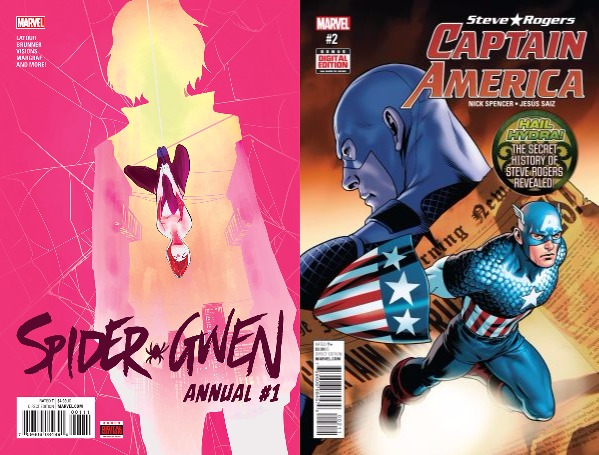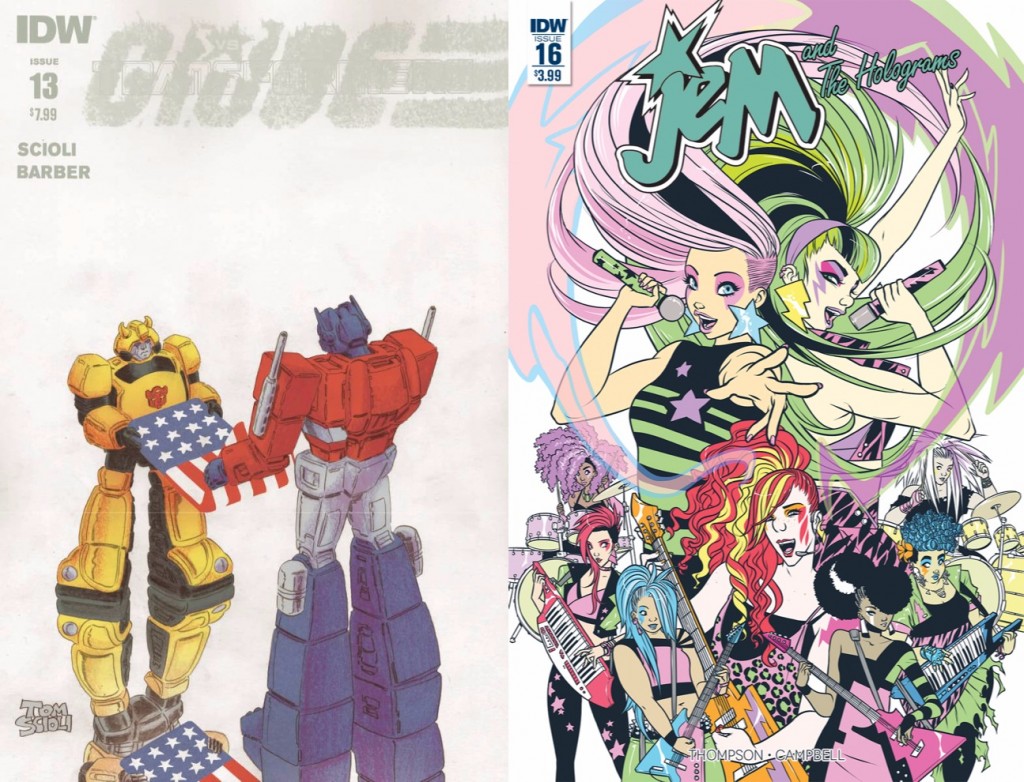Deadshirt Is Reading… is a weekly feature in which Deadshirt’s staff, contributing writers, and friends-of-the-site offer their thoughts on Big Two cape titles, creator-owned books, webcomics and more.
Joe Stando is reading…
Spider-Gwen Annual #1
Written by Jason Latour
Art by Chris Brunner, Emi Lenox, Chris Visions, Olivia Margraf, Annapaola Martello, James Harren, Jason Latour, Michael Walsh, Javier Rodriguez, Alvaro Lopez, and Veronica Fish, with colors by Rico Renzi, Jordie Bellaire, Jim Campbell, John Rauch, and Vero Gandini
Lettered by Clayton Cowles
Marvel Comics
“I swear, some people just can’t live without drama.”
The first of likely many Spider-Gwen annuals takes us on a romp through Spider-Gwen’s life and universe, Spider-Gwen Annual #1 features a bevy of artists working with tonally diverse scripts from Jason Latour. It’s a blast, with a nice mix of styles and stories, but I wanted to focus on the two that particularly blew me away.
The first, by Brunner and Renzi, focuses on the early days of Gwen’s career, before she was even Spider-Woman. It’s a broad reimagining of the wrestling match and robbery that led to Uncle Ben’s death, but with some interesting twists. First is the inclusion of She-Hulk as a wrestling superstar, as well as a favorite of Gwen’s (her fantasy of their life as partners is clever and cute). But it’s also an interesting take on both Gwen and Uncle Ben himself. Rather than an obvious “Gwen foils the robbery!” story, this one has a mix of lucky timing and Ben’s own bravado saving his life. It’s a solid look at the reality of standing up to violent threats, with both Gwen and Ben realizing how close he came to death.
The other one I really enjoyed was the Captain America story by Visions and Campbell. Spider-Gwen’s version of Cap is significantly weird and trippy, and her story was both fun and touching, with an introduction to an aged Steve Rogers almost analogous to Jack Kirby and Joe Simon. Sam’s backstory includes seventy years of interdimensional travel, and her exploits romancing a Prince version of Baron Blood and punching a Trump M.O.D.O.K. were a treat. I’m not sure if we’ll be seeing her in a solo series or crossovers any time soon, but I’d love it.
The key to all these stories is that they’re tightly focused on Gwen and those around her, and the relationships that make them work. With the level of exposure Gwen’s gotten recently, from crossovers to appearances in team books, it can feel like too much. But I’ll gladly take an annual that gets back to basics about (for my money) the most compelling Spider-character right now.
Andrew Niemann is reading…
Captain America: Steve Rogers #2
Written by Nick Spencer
Art by Jesus Saiz
Lettered by Joe Caramagna
Marvel Comics
“Which means you must aim lower”
Disconnected from its bad PR tornado, Captain America: Steve Rogers is a really interesting book. Issue #2 concerns itself with explaining the shocking last page of the previous issue, which revealed that ol’ Cap is *gasp* actually HYDRA and has been this whole time! Say it ain’t so! However, by issue #2 the twist is completely explained away as being a result of Red Skull teaming up with Kobik, a personified Cosmic Cube in the form of a sassy little girl. There’s some pretty great moments in this issue (that mostly include Red Skull getting owned by a child) but also in terms of how Skull wants to “break” Captain America and, in turn, his greatest allies and fans.
I’m positive this is exactly how the story was meant to shake out because the pieces all fit, but I’m not sure exactly where the story goes from here, and frankly I wonder if this Red Skull reveal was a bit too early. The art by Jesus Saiz continues to be great, and I especially love the frames where Red Skull is grinning menacingly in the background. The biggest gripe I have with this issue is how light it is on Captain America himself, and I hope Spencer doesn’t turn this title into a book that primarily focuses on Red Skull. Overall, I dig the track this series is headed down and I think it will prove to be an interesting point in the history of Cap.
Patrick Stinson is reading…
Transformers vs. G.I. Joe #13
Written by Tom Scioli and John Barber
Art, Colors, and Letters by Tom Scioli
IDW
“You crawl out of the underworld to face me…my victory is pre-ordained. To become the new god of the universe I must vanquish the old gods of Primus.”
I’ve been trying to figure out all day what to say about this final issue of Tom Scioli’s Transformers vs. G.I. Joe. It’s too big. Scioli set out to “mic drop” his little corner of the franchise, as he said to Newsarama, and I can’t think of a single way he hasn’t succeeded.
While Scioli has experimented with both form and story over these thirteen (technically fourteen, a story page, and a prose story, all of which are needed to get everything) issues, #13 is classical in its simplicity. Against the backdrop of Megatron, at the peak of his power, about to consume the very sun itself, the Transformers, G.I. Joe, and Cobra engage in the final duels with each other as they abet or hinder him. The mythic nature of the engagement is highlighted by Scioli’s artful use of comics panels from issues past of both franchises…and he is careful to acknowledge ALL responsible creators. For instance, Hawk and Destro may duel on Megatron’s head, but their battle is shown to be an echo of their adversarial existence in every comic, cartoon, and toy chest on Earth. Storm Shadow invokes the karmic cycle in his umpteenth battle to the death with Snake Eyes.
While Scioli has been quick to escalate the Earth/Cybertron conflict both in scale and darkness, here he shows his mastery of the denouement as well. Despite always having about one and a half times as much plot as he can possibly cram into the pages (and this is a double issue!), he finds time to give all of his fifty or so characters a satisfying wrap-up. Despite the fact that the most distinctly different characters in Scioli’s universe—General Flagg, Destro, and Megatron—are all massive dicks, the narrative itself shows a humanist faith that everything can be all right for the vast majority of people of all kinds. When the day is saved by deus ex machina, it’s not a flaw in the context of the central metaphor: the child’s toybox.
Once again Scioli is inspired by the physical features of the toys to create story points never before seen in Transformers, such as the role of Ultra Magnus and the idea that a human can wield Megatron. Unfortunately, one thing that is meant to be a “wow” moment (and this will probably work better for most readers) is a little undercut by the fact that the Transformers franchise has already done the same thing a couple of times, notably earlier this same year. It turns out even Scioli is hard pressed to top the wackiness of the franchise we already have!
Open your mind and dig into this series. A lot of skeptical Transformers fans have compared it unfavorably to the main IDW universe, but it’s not meant to be comparable in style or content. In fact, I’m not even sure I can say it’s definitively better or worse than the previous G.I. Joe/Transformers series, which had a gentler sense of humor and was much more grounded. The highest praise that that I can give this comic is that it’s different. Good different. Deliberately, mind-meltingly, lovingly different. Pick this up and giant robots and puny humans will reshape the solar system for you…but you’ll still make it upstairs when your mom calls you for Taco Tuesday.
Kayleigh Hearn is reading…
Jem and The Holograms #16
Written by Kelly Thompson
Art by Sophie Campbell
Colored by M. Victoria Robado
Lettered by Shawn Lee
“There’s something we need to deal with. Namely…Where the hell is Jem?”
Can two rival bands put aside their differences to put on a kick-ass concert and save the world? Or will their differences tear everything apart? Thompson and Campbell’s “Dark Jem” arc concludes here, and the only folks likely to be disappointed are those who were hoping Dark Jem would devour the D’Bari sun and kill a planet full of broccoli people. Instead, the Holograms recover from the Goth makeovers given to them by the sentient computer virus Silica, and join forces with the Misfits to stop Silica’s evil from spreading.
Jem #16 aims to rock the audience’s face off; it’s a crowd-pleaser of an issue, featuring multiple group hugs, a cute Kimber/Stormer kiss (“OMG! Stimber!”), and a climax that celebrates the Powers of Friendship and Music (capitalized letters very much implied). At the heart of the story is Jerrica’s identity crisis. From the very beginning, she embraced the Jem persona because it helped her overcome her debilitating stage fright, but after Silica brought out her dark side, Jerrica is afraid of becoming Jem again. My qualm with this series is that the shy Jerrica and mysterious Jem isn’t as strong a protagonist as she needs to be to avoid being overshadowed by the comic’s bigger, louder personalities. Complicating this is the fact that Thompson and Campbell have softened her archenemy Pizzazz, making her more likable than her shrieking cartoon counterpart (she even has an adorable kitten!). I wish Jem was more of a superstar.
I must regretfully mention that this is Sophie Campbell’s last issue on the series she helped launch, and I’ll miss her take on these characters. Campbell was absolutely the right artist to bring Jem and the Holograms into the twenty-first century, and she left her mark on the reboot not only with her refreshing and fashion-forward character designs, but also with the character she co-created, the new Misfit Blaze. There was one bit of classic Jem lore I thought I wouldn’t see before her last issue, but rest assured, the ending left me smiling. Thompson and Campbell’s “Dark Jem” arc ends on the perfect note.
Thanks for reading about what we’re reading! We’ll be back next week with a slew of suggestions from across the comics spectrum. In the meantime, what are you reading? Tell us in the comments section, on Twitter or on our Facebook Page!



